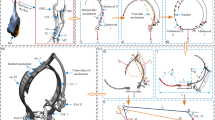Abstract
In recent years, planet exploration has received an increasing interest due to the possibility of exploiting planet resources and assuring a human–robotic colonized presence on suitable planetary surfaces. These goals can be reached through the development of smart robots, which are able to work on their own and without requiring a constant human supervision but, at the same time, assuring a great level of safety and reliability. To this aim, the development of effective architectures, concerning both software and hardware issues, could represent a great improvement toward this ambitious objective. This paper presents a novel modular architecture called Test Bench for Robotics and Autonomy (TBRA), the main objective of which is to create a test bench for rover autonomy missions where different implementations of a particular subsystem can be easily tested, while keeping the rest of the system unchanged. Thus, it allows the developers to be able to compare the results of tests and understand which version works better. Such architecture has been built on top of the Workframe, a generic middleware for real-time robotics. This two-layered approach allows the final user to deal only with the TBRA interface, which is designed to be extremely simple to use and takes care of most real-time programming problems, while allowing flexibility in the development, maintenance and future extension of the TBRA itself.
Similar content being viewed by others
References
Bruyninckx H (May 2001) Open robot control software: the OROCOS project. In: Proceedings of IEEE international conference on robotics and automation, Seoul, Korea, vol 3, pp 2523–2528
Bruyninckx H, Soetens P, Koninckx B (2003) The real-time motion control core of the Orocos project. In: Proceedings of IEEE international conference on robotics and automation, Taipei, Taiwan, vol 2, pp 2766–2771
Volpe R, Nesnas I, Estlin T, Mutz D, Petras R, Das H (2000) CLARAty: coupled layer architecture for robotic autonomy, NASA-JPL Technical report
Volpe R, Nesnas I, Estlin T, Mutz D, Petras R, Das H (2001) The CLARAty architecture for robotic autonomy. In: Proceedings of IEEE aerospace conference, Montana, USA
Nesnas I, Wright A, Bajracharya M, Simmons R, Estlin T, Kim WS (2003) CLARAty: an architecture for reusable robotic software. In: Proceedings of SPIE aerosense conference, Orlando, FL, USA
Nesnas I (2007) CLARAty: a collaborative software for advancing robotic technologies. In: Proceedings of NASA science and technology conference, Adelphi, MD, USA
Urmson C, Simmons R, Nesnas I (2003) A generic framework for robotic navigation. In: Proceedings of IEEE aerospace conference, Big Sky, USA
Jain A, Guineau J, Lim C, Lincoln W, Pomerantz M, Sohl G, Steele R (2003) ROAMS: Planetary Surface Rover Simulation Environment, i-SAIRAS. In: International symposium on artificial intelligence and robotics & automation in space. Nara, Japan
Jain A, Balaram J, Cameron J, Guineau J, Lim C, Pomerantz M, Sohl G (2004) Recent developments in the ROAMS planetary rover simulation environment. In: Proceedings of IEEE aerospace conference, Big Sky, USA
Nesnas I, Simmons R, Gaines D, Kunz C, Diaz-Calderon A, Estlin T, Madison R, Guineau J, McHenry M, Shu I-H, Apfelbaum D (2006) CLARAty: challenges and steps toward reusable robotic software. Int J Adv Robot Syst 3(1): 23–30
Gerkey B, Vaughan B, Howard A (2003) The Player/stage project: tools for multi-robot and distributed sensor systems. In: International conference on advanced robotics, Portugal, pp 317–323
Ando N, Suehiro T, Kitagaki K, Kotoku T Yoon WK (2005) Composite component framework for RT-middleware (Robot Technology Middleware). In: IEEE/ASME international conference on advanced intelligent mechatronics, Monterey, CA, USA
Quigley M, Gerkey B, Conley K, Faust J, Foote T, Leibs J, Berger E, Wheeler R, Ng A (2009) ROS: an open-source robot operating system. In: Proceedings of the international conference on robotics and automation, Kobe, Japan
Henning M (2006) The rise and fall of CORBA. ACM Queue 4(5): 28–34
Maimone M, Cheng Y, Matthies LH (2007) Two years of visual odometry on the mars exploration rovers. J Field Robot 24(3): 169–186
Johnson AE, Goldberg SB, Cheng Y, Matthies LH (May 2008) Robust and efficient stereo feature tracking for visual odometry. In: IEEE international conference on robotics and automation, Pasadena, USA
Author information
Authors and Affiliations
Corresponding author
Rights and permissions
About this article
Cite this article
Simetti, E., Zereik, E., Sperindé, A. et al. A new software architecture for developing and testing algorithms for space exploration missions. Intel Serv Robotics 4, 135–146 (2011). https://doi.org/10.1007/s11370-011-0086-7
Received:
Accepted:
Published:
Issue Date:
DOI: https://doi.org/10.1007/s11370-011-0086-7




